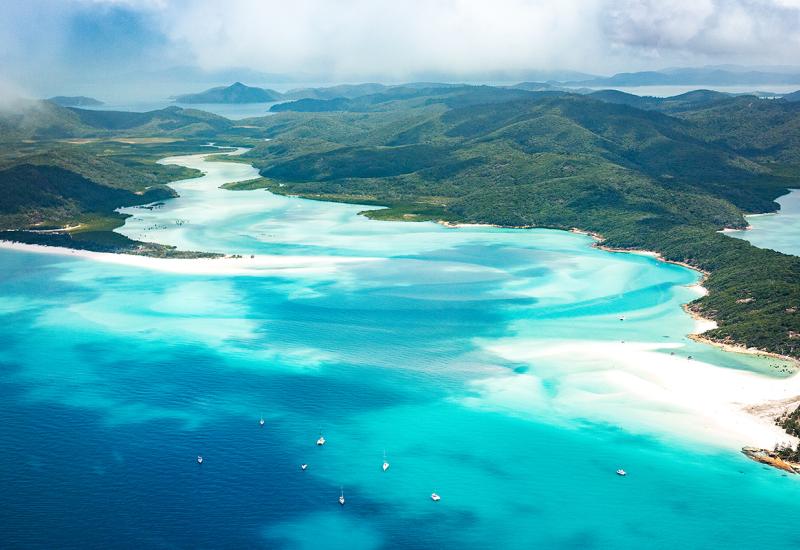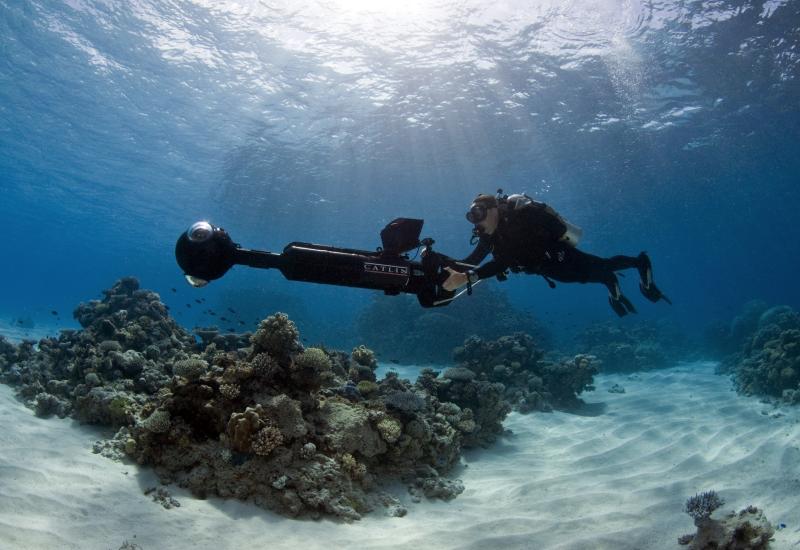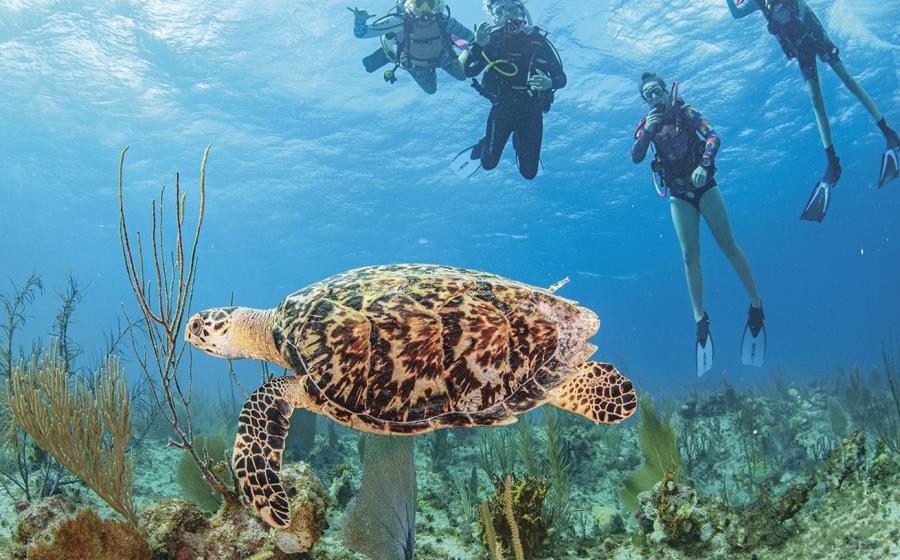Back to Bikini
The longest moments in diving are the last 10 minutes of a prolonged decompression stop.Grasping a bar only a few feet below the surface, I focus on my breathing. With every mechanical hiss and each bubbly rush of exhalation, I visualize the enriched air mixture scrubbing my veins of dissolved nitrogen, doing its work to keep my body from becoming bent.I've never considered myself a tech diver, but hanging off 55 minutes after a 25-minute dive is beyond the bounds of recreation. If you're spending twice your dive time mindlessly hanging on a bar, that 25 minutes on the bottom had better be worth it. At Bikini Atoll, it is and then some.After a three-year absence, divemaster Fabio Amaral had lured me back with tales of what he'd discovered since my previous visit. Then, I had been one of the first diving journalists to visit Bikini, the site of U.S. nuclear tests over 50 years ago. During Operation Crossroads in 1946, two atom bombs sent 21 ships to the bottom of Bikini Lagoon. Many had a glorious history, including the U.S. aircraft carrier Saratoga, the battleship Arkansas, thesubmarines Pilotfish and Apogon, and the notorious Japanese battleship Nagato. From its command bridge, Admiral Isoroku Yamamoto gave the order, ''Climb Mount Nitaka,'' launching the attack on Pearl Harbor. We would soon be swimming on that bridge.Since my last visit, a few aspects of the ships have changed. The deck of the Saratoga is now covered with filamentous red algae, softening her harsh contours. The fragile airplanes in her hangar deck continue to deteriorate. But the biggest difference is accessibility to interiors of the ships that weren9t diveable before.Fabio and his team have installed four lines inside the Saratoga, through hallways, the admiral's quarters and into the heart of the ship, the CombatInformation Center. ''We9ve only been to three of Sara's eight decks, so there's lots more to explore,'' he said. ''Most of the Nagato lies at 160 feet, but we've been in bathrooms and machine shops, we've seen china,boots, teacups and machinery. Because of narcosis, our memory isn't that great, so it takes lots of dives to sort things out.''Bikini offers some of the best wreck diving in the world. But is it safe?The purpose of Operation Crossroads was to test the effects of an atomic bomb on ships. Each of the vessels were rigged for combat, with full fuel tanks, live munitions and bombs on board, and airplanes on the flight and hangar decks.At the time, the tests were extremely controversial. Dr. J. Robert Oppenheimer stated the obvious: ''If you set off an atomic bomb close enough to a warship, you9ll sink it.'' Although most of the 71 ships in the tests were damaged to some degree, only 21 were actually sunk. But the rest were so heavily contaminated with radiation that all were scuttled in the deep ocean, sunk in gunnery exercises or scrapped.Ever since the tests, the U.S. Department of Energy and its predecessors have been monitoring radiation at Bikini. Background radiation today is less than any large city. The soil, however, contains radioactive cesium, which concentrates in the plants and their fruit. Therefore, you can't eat anything that grows there; all food is imported.A half-century of time has cleansed the wrecks of radiation; the real danger for divers is depth. With the bottom of the lagoon at 170 to 180 feet, every dive requires decompression.''We aren't really a technical environment here; it's like a twilight zone between that and recreational diving,'' Amaral explains. ''A tech diver can bring all his toys and have a lot of fun. Advanced recreational divers will learn that deco diving won't kill them or get them bent, in addition to a lot of new skills.''A three-level trapeze dangles from the dive boat, with stainless-steel bars 20 feet long. Hanging from on-board tanks are a half-dozen second-stages on long hoses, providing a 75-percent oxygen mix for the 20- and 10-foot stops. This reduces decompression time by one-third. But for a greater safety margin, deco times are computed as if using air.In three years, among divers of all ages and varying ability levels, there has been only one mild case of bends.''When I started I was scared to death, having never handled deco diving,'' Amaral says. ''We have a saying back home in Brazil: `This is too big a load for my truck.' It's too much for my knowledge.''So Amaral turned to experts in the field, namely Tom Mount and Kevin Denlay. ''Kevin trained us all the way to tech nitrox; Tom gave us the tri-mix course. By watching them and how they do things, I've ended up learning a lot.''Inside the SaratogaDuring my week on Bikini, six of 14 dives were on the Saratoga. We barely scratched the surface of her possibilities. Consider that this 880-foot ship is longer than the Titanic, with 140 feet of vertical relief from her keel to the top of the island.We entered Saratoga at the forward elevator, turned a corner into darkness, and followed our light beams down a short corridor. Our bubbles dislodged a rain of rusty particles from the ceiling, quickly compromising visibility despite our careful cave diver's kick that was intended to avoid stirring up the thick layer of silt from the floor.Drifting through a hatch and an antechamber, we entered the Combat Information Center and spotted a chart locker that once held classified maps. Weaving among the communications devices -- ranging from microphones and telephones to big, boxy tube radios festooned with gauges and dials -- Amaral aimed his cave light on a radar screen, revealing etched lines and concentric circles. I could imagine the tension in that room as Navy personnel coordinated combat operations on the massive ship.Backing out, we followed another corridor to the admiral's quarters, home to Bull Halsey when he commanded the vessel. Chairs were strewn around the floor. Next to the desk was a wall phone on which we could still read the numbers.A barber's chair dominated the officers' barber shop, which also contained a sink and mirror. Personal matters had to be taken of, even in the midst of war. Our final stop was the china closet, where white porcelain dishes and cups still displayed the blue trim of the wartime Navy. Fabio held up a wine glass, his light illuminating the crystal.Nothing may be moved or taken from these wrecks. Short of finding a virgin wreck of your own, this is the closest you can come to a time capsule of the military world of the 1940s.A Whole New PerspectiveAmaral and I climbed our own Mount Nitaka on the wreck of the Nagato.A prize of war, she and the German heavy cruiser Prinz Eugen were considered to be symbolic sacrifices at Bikini. Wearing a headband with the name of the ship in Japanese, Fabio posed for photographs next to her gigantic 16-inch guns, the largest and deadliest of their time. They are located underneath the hull, which is upside down and precariously balanced on the wreckage of the superstructure, leaving around 15 feet of swimming room between it and the 170-foot bottom.We entered the hull where the stern had broken off, passing through three rusty rooms. It was strange looking down on skylights, until my nitrogen-fogged brain remembered everything was upside down. Amaral picked up a brass bowl, which he surmised was used for melting lead. Finally, we went outside to film the four massive propellers, standing upright like the legs of a dead animal.On this dive the entire aspect of the Nagato came together for me. I was able to relate what I saw underwater to what I had shot three years earlier, and to the charts and diagrams. It's a whole new perspective now that Fabio is in his fourth year here. He knows these wrecks better than anybody.''There's a challenge to get things working smoothly here in a place so isolated,'' he said. ''This is the best wreck diving in the world; there is so much history here.''Every time I go down I imagine those kids, 18 or 20 years old, holding these guns and fighting the enemy navy.''










